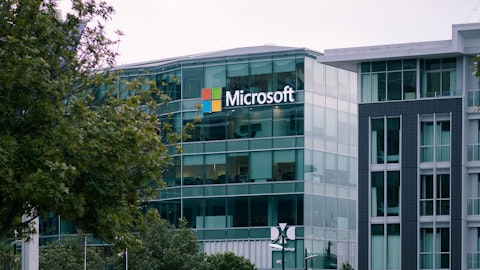Dennis Geiger: I just wanted to ask another on pricing and sort of anything you’d call out that you’re seeing from a pricing perspective and any sort of resistance from the customer at all? And then, Matt, I think you gave the 2Q, as we think about rest of year on the pricing side, we just kind of assume continued moderation in that pricing level over the balance of the year?
Matt Clark: Yes. I mean, I think just, I would still just use about 4%. I mean, we take it twice a year. We haven’t finally decided, that’s still in process but I think just for modeling purposes, that’s probably a good number. I mean, from our perspective, with flat traffic, obviously, the guests are coming in the door the same as they were before, despite the pricing. And so, I think that’s a positive. We understand the mix. It’s behaving like we thought it would be. So they’re not changing their behaviors. It’s kind of just normalizing. So, overall, I think that we think that our guests appreciate the value of Cheesecake Factory and North and all of our brands based on the quality, the portion sizes, all of the things that have endured for nearly 50 years and people come back to their favorites, you know and so, I think that’s what’s happening.
Dennis Geiger: That’s great. And one quick follow up, I guess, just on that point, Matt and I think you talked to mix earlier, where I think both the alcohol and sort of broader attach, it’s a little bit more lapping the exuberance from prior years and you’re still above 19. So it’s essentially really not seeing any observable trade down behavior from any cohort of guests, forget alcohol, even sort of on sides, et cetera, just not seeing that, basically?
Matt Clark: No. I would say we’re not. Yes, that’s correct. Yes.
Operator: Our next question comes from Jim Sanderson with Northcoast Research.
Jim Sanderson: I wanted to follow up a little bit more on G&A spending. I think the way guide is looking, that’s going to outpace revenue growth for this year. But maybe you could talk a little bit more about how you’re managing that line item? What we should expect as far as potential for leverage going forward?
Matt Clark: Sure. You know like I said, for the quarter, we had a couple of items that were sort of out of pocket. But I think generally, our goal is to try to get back towards a 6% level. And sometimes just the timing of the spend versus the timing of openings where revenue can just be a little bit different on the margin side. So that is still our goal. I think we do a good job of managing the core functions of the business and I’m pretty confident that we’ll get that aligned in the next year or two.
Jim Sanderson: All right. And a quick follow-up question on North Italia. Could you provide traffic and check mix or traffic checks, of the two?
Matt Clark: Etienne, do you have that?
Etienne Marcus: I do.
Matt Clark: Okay.
Etienne Marcus: Traffic was negative 1% for the first quarter. Price was 8% and mix was negative 4%.
Matt Clark: We would add the same comment where they were also impacted just like Cheesecake. So, I think we would have been in positive traffic territory if it weren’t for the weather in January.
Operator: Our next question comes from Rahul Krotthapalli with JPMorgan.
Rahul Krotthapalli: I just wanted to ask, on the kitchen display system, can you discuss or quantify to the extent possible, how much of the throughput or ops efficiency impacted your earnings this quarter? And is this something new, or did you have something in place for a while on the lines of kitchen management system or is this a fully blown upgrade and what was the pace of rollout?
David Gordon: This is David. Just for clarity, the kitchen display system is at Flower Child is where we rolled that out. We have had a kitchen display system at Cheesecake Factory for numerous years. So the full rollout was probably done at the beginning of the quarter at Flower Child and we’re not sharing any of the data at this point but we do know that it’s made some good strides and benefits for the guest experience with throughput, the dine-in experience being faster than it was previously and really allowing them to manage the throughput of off-premise and dine-in because at Flower Child, you’re talking about a 55% off-premise mix. And one of our goals is to ensure that that high off-premise mix does not extend the dine-in time for any guests that are coming in and dining with us. So it’s been very beneficial to this point. And it’s fully rolled out at all the Flower Childs and we’re including it in all the new restaurants as we open them as well.
Operator: Our next question comes from Brian Bittner with Oppenheimer.
Brian Bittner: I apologize if this has been addressed but I’m going to ask it anyway. Just on the margins, the margin expansion was very impressive in light of a choppy sales environment out there. And I know you’ve talked a lot about some wins in the quarter that helped you outperform on the margin. But on that other operating expense line, the leverage there was pretty unexpected and positive. And I think you mentioned utilities and I think you mentioned to-go item packaging. Are those pretty structural new opportunities that you are driving in that other OpEx line? And should we continue to expect this type of leverage in that line, because if you got it with sales slightly negative and now sales are going to be better than that, I’m just curious if we’re still going to get a lot of margin expansion from other operating expenses.
Matt Clark: So Brian, I think you got most of that right. I think we would say, look, the utility costs can vary outside of the control of the company, so that’s not necessarily a permanent structure. We’ll see where that goes to. Certainly, supply chain savings will continue but we’re not factoring in any continued leverage in that line item at this point in time. If we can manifest and improve it, that’ll be great but I think we’ll see how each quarter plays out. Certainly, we expect the cost of sales benefits to continue at a very meaningful rate. And we probably expect labor to be about equal, just like it was. So just kind of running through the P&L there.

